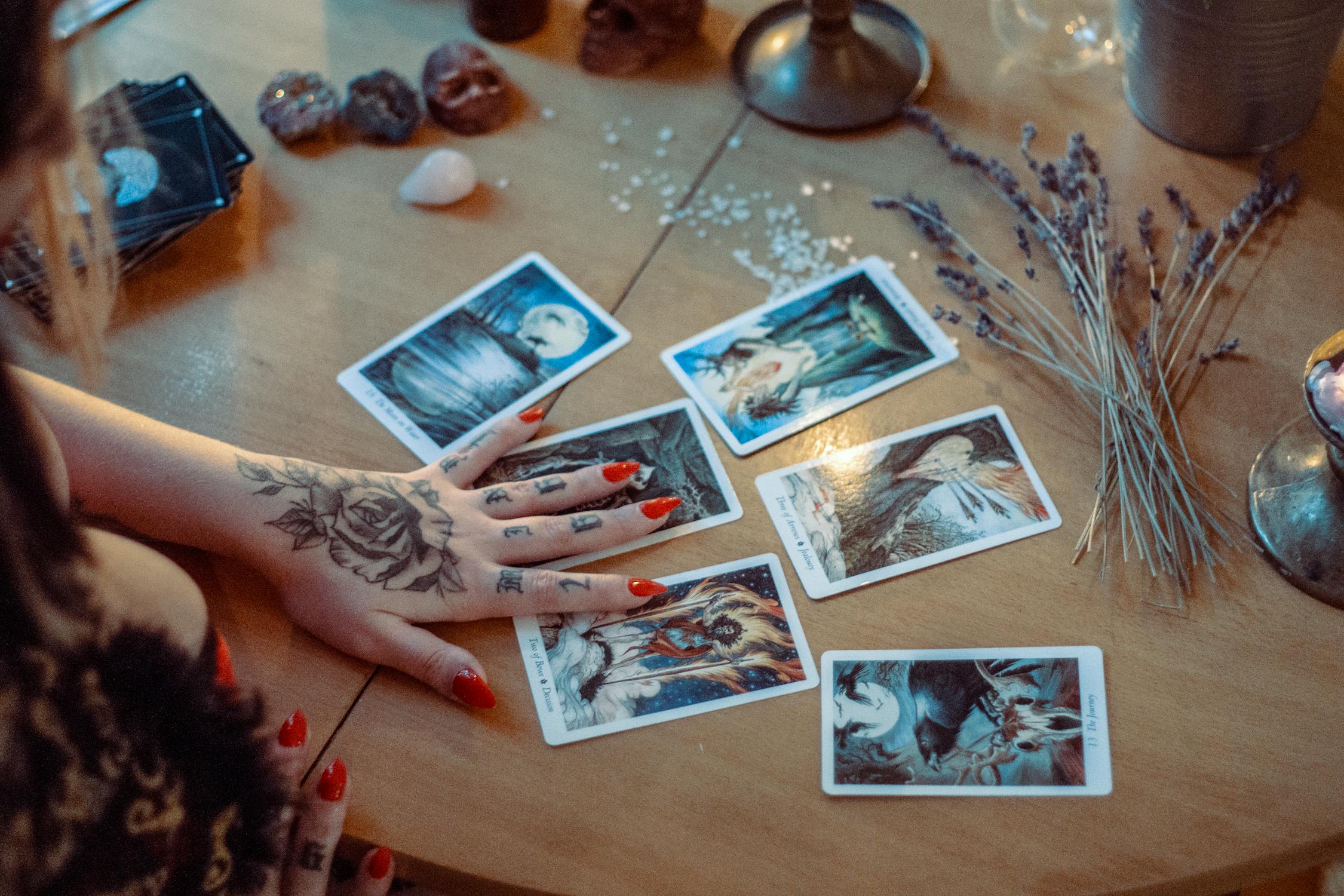Posted on March 01 2021
THERE IS QUITE A BIT OF MERIT TO THE USE OF TAROT CARDS AND OTHER "SPIRITUAL" PRACTICES IN VARIOUS FORMS OF THERAPY. INTEREST IN THE OCCULT HAS BEEN ON THE RISE OVER THE LAST 40 YEARS AND HAS CONTRIBUTED TO A NUMBER OF CULTURAL SHIFTS, INCLUDING HOW MANY OF US APPROACH NOT ONLY SELF-CARE, BUT MENTAL HEALTHCARE AS WELL.
By Jax Cassidy
Tarot seems to be a thing that professionals and clients alike are fairly split on, but has undoubtedly piqued enough interest to warrant exploration within various therapeutic frameworks. Turns out, tarot isn’t just a trend among self-proclaimed oracles or millennials suffering from affluenza. Before you scoff at the idea that a tarot session can help those struggling with their mental health, you might want to keep reading.
In order to be more open to the idea of tarot reading as a valid therapeutic exercise, you should cast the association between tarot cards and fortune telling out of your head. Any tarot enthusiast worth their salt will tell you that that’s not actually what tarot cards are for. The cards don’t tell you what’s going to happen. They don’t predict your future. They empower you, the querent, to take the future into your own hands. In personal use, the cards are messengers with insight into your past, present and potential future. The illustrations on the tarot cards are more than just aesthetically pleasing. By analyzing these images, a person could unlock a solution to a problem that’s been plaguing them, whether they’ve realized it or not. In other words, the cards can’t bring to light anything you don’t already know, but they could offer a fresh perspective. That’s one of the things that makes them a useful tool in psychotherapy.
Tarot in therapy looks a bit different from what you’re probably expecting. A therapist isn’t going to give you a tarot reading and immediately have a comprehensive diagnosis of your situation. There are two common ways that a therapist will incorporate tarot in a session: by allowing the client to draw cards at random from a shuffled deck, or by laying the deck out face-up and having the client draw the images that stand out to them the most. This empowers the patient to learn more about themselves and constructively approach their issues. 1-3 cards in a session is typical, but some therapists who specialize in this practice might opt to do a spread of 10 or more cards, depending on the patient. It may be optimal to keep a reading short and sweet, but if the exercise is clearly a productive one, more cards can be utilized for an in-depth session.
There are a number of reasons that tarot therapy has seen a rise in popularity among therapists and clients alike. A tarot deck is rife with metaphors and symbolism, adding an air of the mystical to what would otherwise be a standard session of talk therapy. It’s unsurprising that people feel drawn to doing an exercise that feels special. And it doesn’t hurt that this particular exercise also empowers the patient to draw their own conclusions without much facilitation from the therapist. Putting inner turmoil into words isn’t a natural thing for most people, but generally we’re more likely to open up when we feel comfortable, and nothing breaks the ice like the intrigue of a tarot deck.
Once you work through the symbolic imagery, you’ll realize that the images on the cards depict common archetypes in relatable situations with an inherently neutral tone. Tarot cards present universally human complications in a pretty package. It’s the fact that the cards are neutral and universally relatable that makes them a perfect tool in psychotherapy. What’s important to remember is that every person is going to interpret the message of the card in a different way. Because not only is each person unique, but the way each person applies the symbolism of each card to their own situation will vary.
Professionals might liken the practice to the use of something like a Rorschach Test. It boils down to the same basic principle: the patient takes in the image and makes certain associations with it. These associations can offer a glimpse into the patient’s mind and help reveal what’s affecting them. Examining the images that feel relatable to a specific troublesome situation can also help the client explain complicated emotions or thoughts in a way they struggled with before. The cards ultimately act as a storyboard for the patient’s current issue. Looking over that storyboard of images that speaks to the client can help to simplify problems that originally felt too overwhelming to explain. Each separate image contributes a plot point to the story, even if the story’s hard to tell. When words fail, art stirs the truth to the surface.
What can we take from this? Here in the U.S., our healthcare system is daunting. It can be scary to seek help in the first place. If you’re thinking about looking for a therapist who specializes in tarot reading, you may have to ask around. Most professionals don’t advertise that they bring out a tarot deck with their clients, even if it is only occasional. Stigma still surrounds occult practice, even as a therapeutic tool. That being said, if you have a therapist you’re already happy with, it couldn’t hurt to ask if they would explore this with you.
Some might say this specific form of talk therapy isn’t exactly something you can DIY. I can understand this perspective, but I don’t agree. In fact, self-readings have been an important asset to my self-care routine over the years.
However, I do think that for self-readings to be accurate and productive, the querent requires a certain level of self-awareness. It can be difficult to approach a tarot deck with a deeply personal issue and NOT twist the meanings of the cards into what you want them to be. Tarot reading can be an excellent outlet when it comes to doing your shadow & inner child work, both of which I think we’ve all been tangled with over the last year. If you can approach a reading and analyze the imagery with brutal honesty to yourself, then tarot cards can absolutely be beneficial to your personal mental health journey.
The good news is, you don’t need to know absolutely everything about tarot to get started. You don’t need to have the prettiest, most expensive deck. You don’t even need to have the meanings of each card memorized and be an expert on symbolic messaging. It’s not necessary to start with lengthy, complicated spreads. If you delve deep into something new too quickly, you’ll overwhelm yourself. This is never ideal when it comes to a practice that you hope will benefit your mind & spirit. I’d suggest starting out each week by drawing 1 card, taking a moment to interpret the image and reflect on what associations you make between that card and your life. You can also do this with a three-card spread, if you’re seeking a more in-depth evaluation and feel comfortable doing so. For example, with a three-card spread, you can view the images as a plotline. There’s a starting point, a middle, and a conclusion. You can interpret these individually or as a whole. Individually, the cards may be relevant to multiple situations. Alternatively, all three cards together could point to one larger issue. However you interpret your reading is up to you.
Another recommendation I have for you is to incorporate your self-readings into your journaling. Even if you don’t have a journal, start one for this purpose. Write your interpretations of your card(s) for each week. It doesn’t have to contain anything super profound or detailed. Come back at the end of the week and write a short passage reflecting on what the reading actually applied to and how you’ll carry that message moving forward. This journal will be a helpful log of your readings that you’ll look back on to see what progress you’ve made in various areas of your life. (Remember, progress isn’t linear. Don’t put pressure on this exercise. Let it develop naturally.)
If it would make you feel more secure to have a grasp of it before you delve into a deck, there are tons of books and other resources on the subject. Or maybe you have a trusted friend who’s into tarot who can help you learn the basics, or even take you through your first few readings via facetime. (Even better, if you know someone online who offers readings and you have the funds to support them, have them read for you and take what you can from their expertise. Self-readings can be a beautiful thing, but an extra pair of eyes can never hurt to make some progress.) There’s a beautiful community to discover in the world of tarot. Don’t be intimidated by being new to it. The evolution of each person’s journey with tarot and other spiritual practices looks very different, so if you feel like somehow you’re doing it wrong, try to remember everyone starts at the beginning.
I hope that the information here was helpful to motivate you as you start on a new road to emotional fulfillment. Even if you never plan to touch a tarot deck, different spiritual outlets hold possibilities for growth. Whatever you choose, blessed be.
Jax is a freelance writer and content creator who strives to deconstruct tired ideals of beauty and create a safe and supportive space for all in her little pocket of the internet. She’s passionate about writing and teaching, as well as being an advocate for mental health awareness (being someone who struggles with depression and anxiety herself) and equality for all. You can find her on Instagram.



0 comments